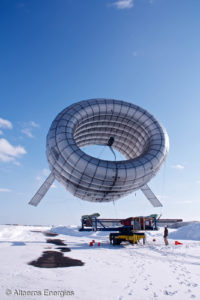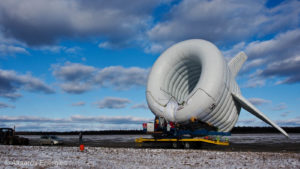
Bringing power to remote island communities, military bases and disaster-relief sites is a daunting task, dependent upon expensive diesel generators and regular deliveries of fuel. The Massachusetts Institute of Technology (MIT) set its sights on the $17 billion market for remote power and “microgrid” power generation, using its engineering expertise to harness consistent, high-altitude winds through Buoyant Airborne Turbines (BATs). These helium-filled inflatable aerostats (lighter-than-air craft) resemble gigantic donuts with fins; each one can provide power for more than a dozen homes.
Altaeros Energies, formed out of MIT research and headquartered in Cambridge, Mass., demonstrated its BAT in Alaska, partially financed by the Alaska Energy Authority’s Emerging Energy Technology Fund. The $1.3 million, 18-month project to harness high-altitude winds at a height of approximately 1,000 feet may lift Altaeros to the top of a very competitive field. Entrepreneurs and would-be energy moguls worldwide are seeking ways to provide reliable, low-cost power anywhere an aerostat can be tethered to the ground. The BAT can be transported and set up without the need for large cranes, towers or underground foundations that have hampered past wind projects, says Ben Glass, Altaeros CEO.
 The BAT’s critical components include the shell, made of a proprietary gas-tight, durable performance industrial fabric. The shell aligns to changing winds and funnels air through the turbine. (It may also carry other gear, such as cameras or sensors.) The turbine is a lightweight, conventional three-blade horizontal version. The tethers serve the dual purpose of holding the BAT in place and conveying energy down to earth-bound users. Finally, a portable ground station contains autonomous controls and power conditioning equipment. The BAT generates twice the energy of a comparably sized turbine attached to a tower. Investors in the Asia-Pacific region, where remote locations and widely dispersed islands pose an energy challenge, have stepped up to support BAT development.
The BAT’s critical components include the shell, made of a proprietary gas-tight, durable performance industrial fabric. The shell aligns to changing winds and funnels air through the turbine. (It may also carry other gear, such as cameras or sensors.) The turbine is a lightweight, conventional three-blade horizontal version. The tethers serve the dual purpose of holding the BAT in place and conveying energy down to earth-bound users. Finally, a portable ground station contains autonomous controls and power conditioning equipment. The BAT generates twice the energy of a comparably sized turbine attached to a tower. Investors in the Asia-Pacific region, where remote locations and widely dispersed islands pose an energy challenge, have stepped up to support BAT development.
 TEXTILES.ORG
TEXTILES.ORG


